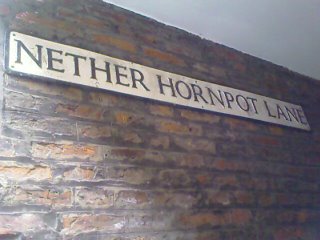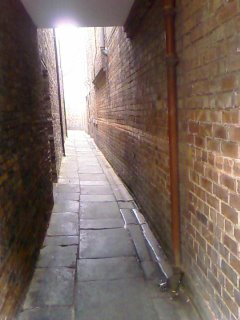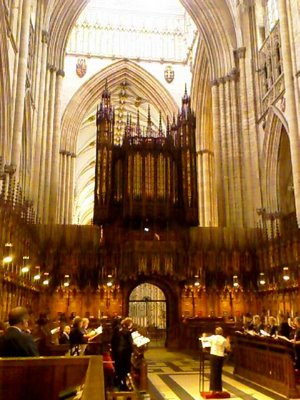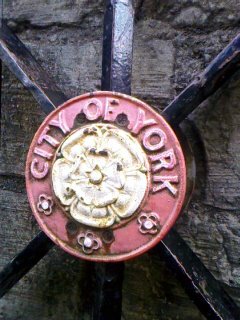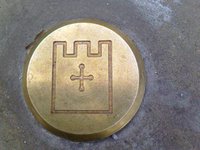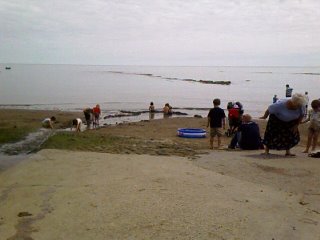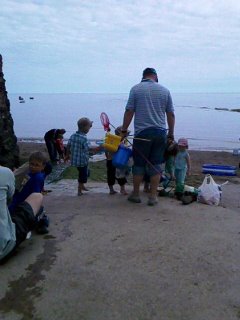
The last weekend of my three-month holiday is back in London, where I spend the time reacquainting myself with neighborhoods, reconnecting to friends I met with three months ago, and handling the logistics of getting out of a city whose main airports are now constipated by a fear-driven mentally of batten-down-all-the-hatches, give-no-mercy-to-infants-or-the-infirm, and suspect-everything-as-contraband high-level security.
A couple of days ago, Norman had sent an e-mail in which he alluded to some upcoming travel trouble, but having been blissfully unaware of out-worldly goings-on during the C2C and in York, I was merely baffled by what he meant.
It is from Maria, a Spanish roommate at the York YHA, that I get the first whiff of what’s in the wind for getting out of London. We are packing up bags and tidying bunks an hour before we leave together for the York train station on Saturday morning. She asks what I think of the day’s headlines about events at the airport. I stop, a shirt poised mid-stuff in my pack, and ask what she means. All that registers are phrases like “tightened security,” “bomb threats on Thursday,” “all flights cancelled.”
Eyes widening and heart dropping, I pull her newspaper to me. Cover story. Page after page expounding on the aftermath and upheaval from an apparently thwarted terrorist plot on British Airways in London on Thursday and Friday. They are maddeningly vague on the details of the threat—nothing concrete to report, really, at this early stage of investigation. But something about using false bottoms in water bottles to smuggle explosives and then using batteries from mobile phones to set them off. And the prospect of other bombing schemes that authorities may not have detected yet.
As with 911 in the US, reactions to the threat are swift and extreme, based on scant information and an ample dose of alarm that, of course, means mayhem at the airport. Security closes like a noose around everyone and everything related to travel. No carry-on luggage. No strollers or diaper bags. No purses. No packs. No wallets. No water. No food. No medicine. No electronics. Zippo. Put your passport, keys, cash, credit cards, tickets, and tampons into Ziploc bags and welcome aboard to flight #56 to all points non-British. Put all the rest into the hands of severely overloaded luggage carriers and systems, and pray they meet up with you in the end.
I get more information throughout the day. Heathrow is a mess, and will be backed up for days. Endlessly delayed flights. Stranded passengers. Lobbies overflowing with luggage and red-eyed travelers. People camping out in parking lots, running out of airport-supplied sandwiches and water, most British Airways flights canceled. Thank god I decided to not go with them this trip. I leave Tuesday on Continental from Gatwick, which, while also under security clamp-down, might have a faster return to normalcy.
By habit, I travel only with carry-on, and the prospect of all this self-delusional, “we can keep everybody safe by manic hyper-vigilance” security nonsense pisses me off. I’m most aggravated at the thought of packing my trusty little Pocket PC, Perry, and releasing it the custody of airport handlers or the mail. The thought of having all my travel records lost forever amid terror-fed disorganization doesn’t thrill me.
Petty concerns, I know, but I often wonder if the whole gain of terrorism isn’t in the buildings or lives they take down—it’s in their ability to trigger us into crippling our own infrastructures by our predictable, knee-jerk response to threat. It’s that marvelous, disturbing
Twilight Zone episode, “The Monsters Are Due on Maple Street,” played out for real.
Today is Saturday, though, and I leave Tuesday morning. Maybe things will blow over a little by then. I decide to keep an eye on the news and begin to lay plans for getting me and my stuff (some of which has been piling up at Norman and Jean’s house) back to the US with the least amount of schlepping and hassle. Will be weird traveling with absolutely no carry-on, though.
* * *

My London lodging is the YHA hostel behind St Paul’s Cathedral. Good location. Way more expensive than most other hostels—prices rival the Glynne Court Hotel that I stayed at in May, in fact. Nicer amenities, though. Wider staircases (lots of them, as usual), decent cafeteria, cute outdoor courtyard, noisy lounge, many bathrooms and showers (not all of them ones I’d like to use). One shared room tonight and a single room for the next two nights that’s right next to a 3/4 bath at the end of the hall.
It feels good to come back to London and to stay at St Paul’s, almost where I started my touring. This circle of travel feels complete. By now (my fourth or so trip) London is a familiar city, familiar enough that I can set a general direction by map and don’t get so easily lost when I wander.
It’s mid-afternoon, and I need to drum up some evening action in the shape of Saturday dinner and theater. I strike out for Salieri restaurant, Mom’s favorite haunt on the Strand (she goes there every time she’s in London, which can be several times a year). She’s insisted that I look them up to introduce myself and have dinner there. She’s told them all about my being in the UK for the summer, and to be on the lookout for me to come in. I was feeling too shy to approach them the first week I was in London, but that bashfulness is long gone after three months on my own.
The restaurant is empty this early in the day. I am aware of lots of reds and golds and bold-colored oil paintings and gilded theater props festooning the ceiling as I head for the concierge area at the back of the restaurant. I meet a short, swarthy young man in a fine waiter’s uniform—black suit and white shirt.
“Hello,” I say, “I’m looking for someone named Sandy. Is he here?”
“There’s no Sandy here,” the young man says in a Middle Eastern accent I can’t place. “How can I help you?” He’s not looking very willing to help. In fact, he’s looking as if he suspects me of being on a stakeout for a late-night robbery.
“I—er—uh.” I feel my face redden. Maybe I got the name wrong. I fish wildly for Perry, which has the contact info Mom had given me, and I babble an explanation of my presence, falling back on what Mom had suggested I say, feeling a little foolish to be namedropping some American dame this fellow may not know.
“My Mom sent me—Joanne? She comes here all the time. The blonde. From the United States. She said she’d tell you that I might be coming in. I’m her daughter.”
The man’s brown face goes from blank to fully lit. His black eyes and white teeth shine. He stabs at a snapshot that’s tacked above the cash register: a laughing, outgoing, sixty-something woman is surrounded by the Salieri crew, including my host.
I laugh, relieved. “Yep, that’s my mom!”
“Welcome, welcome!” He hugs me greatly. “I’m Sammy! Sammy Jr! What took you so long to get here?”
I mutter something about needing time to settle into London, other things to take care of.... He doesn’t look convinced, and I finish, “But I’m here now.”
“Yes, yes. And your mother. She’s coming again in December!” He continues to beam and introduces me to a waitress, Kate, who has overheard our greeting and whom Mom hasn’t met yet. “This is the daughter of Joanne, in the photo. Nice lady,” he says of my mom.
It’s too early for dinner (only four thirty), so I arrange to return for a pre-theater meal before I see
Donkeys’ Years, a comedy that’s playing nearby. (Very good farce, precursor of the even funnier
Noises Off by the same writer). When I come back, Sammy Jr has gone to the barber, and I must introduce myself all over again to Sammy Sr, owner, father, and generous man who also pulls me into an immense hug and puts me down at a private table away from the main traffic of the front door.

The booths here are painted with crowds of cartoonish people, and even though it’s early yet and the dinner rush hasn’t started in earnest, I somehow don’t feel alone.
As this is to be my last fancy supper in London, I decide to go all out. I order the filet medallion and ask Sammy Sr about the vegetables, which aren’t listed with the meal.

“No, no. We’ll take care of you,” Sammy insists. He sits down beside me in the booth while the waitress takes my order, and we talk about his restaurant, which he has been running since 1978, and about family and life in general.
“Waking up is a gift,” says Sammy Sr. “Take each day as it comes.” Wise words from a man who has lived some years.
The restaurant steadily fills and the number of folks being turned away without reservations speaks for the long-term quality of Sammy’s restaurant and service.

My filet “medallion” ends up being a full-out steak standing beside an artistically presented potato and tomato Cootie Bug-like critter that makes me laugh out loud. The bowl of fresh snow peas, fine beans, and carrots that comes with it is enough to feed the table next to me, as well. As the food keeps coming and I protest at the amount, Sammy Sr winks. “We have to take care of you or we get into trouble.”
The dessert I order—a luscious blood-orange mousse—comes with an added plate of fresh fruit big enough for three. Plus, bless him, Sammy puts a 25% discount on top of it all, much of which I convert into a fat tip.
As I waddle through the crowded theater district to the Comedy Theater, I realize that I like London...in small doses. It’s places like Salieri and people like Sammy Jr and Sr who keep the scale human. Otherwise, it can be just as faceless as any other destination city, so overrun with visitors that it’s hard to find the locals.
* * *
Sunday I play tourist with a dash of feeling like a local because I meet with two London-based friends. First is former Seattleite Sara for breakfast at Pain Quotidian in Maryleborne. It is great to catch up and share travel stories over buttery, jammy croissants and hot tea. She and her husband have done a lot of walking trips, including Nepal, and she shares the same love of walking as I do as a form of transportation.
My next two hours are spent on foot getting from Maryleborne to St Paul’s, via Mayfair and the Ritz, then the Embankment along the Thames, to meet up with Bath-met friend Sarah on St Paul’s steps. We intend to eat lunch and visit the Tate Modern across the Thames.
We actually end up eating at the Tate Modern’s restaurant—pricy but very good food, company, and view. We take in the standard Tate Modern exhibits, and I’m mostly unimpressed with the works—while some invite longer study, not much if this is my style...whatever that is. Whimsy, I suppose, is closest to it.
Sarah and I giggle and roll our eyes over some of the more extreme offerings and their oh-so-important sounding appraisals. I mean, who can really be serious speaking in hushed tones about the universality and rational aesthetics of a slashed canvas in a frame, or of a fluorescent light bulb mounted diagonally on a wall, or of a field of zinc and steel plates laid out ungrouted on the floor? Sometimes I wonder if artists aren’t really smirking at all this to-do, their tongues firmly planted in cheek, pulling a joke on all us grandiloquent, swooning art critics and patrons. The ultimate in whimsical art, perhaps?
It dumps rain as we leave the Tate, and Sarah and I huddle umbrella-less under the steel Millennium Bridge stairway with dozens of other folks, trying to stay out of the drips and marveling at the amount of water that is gushing down the walkway and disappearing into drains to the Thames. The squall passes quickly.
We soon part company for the evening, and I return to my final night of packing. I’ve decided to mail all my (mostly dirty) clothes home on Monday and use my rucksack to carry all my souvenirs and gifts back to the US on the plane. No need to bother with a second bag on what will undoubtedly be a hairy travel day, although the clothes will take up to six weeks to arrive home.
* * *
Monday morning, the BBC reports changes in security levels: a small carry-on will be allowed, the size of a small briefcase, and so will small mobile devices. Hurrah. I can go back to Plan A for bringing Perry and the daypack on board.
My last dinner for the trip, appropriately, is around the dining table with Norman and Jean, with whom I shared my first meal three months ago. Norman has me meet him in London after his work day, where he’s been serving as a guard and greeter at the Goldsmiths’ Hall on Foster Lane at the top of Cheapside Street (a “market” street, with guilds and manufacturers on side streets).
Happily, he can give me an after-hours tour of the place. Goldsmiths’ Hall is for the gold and silver workers, and a new prime warden (like a president or chairman of the board) has been voted into the guild every year since the 1300s. (This guild is also the origin of the word “hall mark” for proof of quality and integrity of coin at the assayers office nearby.)
The building was built in 1800s, after a rebuild in 1660 following the infamous London fire. Right now, it’s in the middle of its annual, two-month-long, floor to ceiling cleaning. Furniture has been removed from some rooms and crowded into others, canvas drop cloths cascade down the double staircase, and there’s an overall sense of upheaval to the place. Massive, six-foot wide crystal chandeliers have been lowered for cleaning. Even this disorder, however, can’t fully disguise the hall’s opulence and grandeur.
The building’s interior walls are more than three feet thick (requiring two oak doors and a cavity that acts as a short passage) and covered with wood and ten types of marble from Italy. Brown, green, cream, pinks. Ceilings soar three stories up, painted white and gilded; other rooms in wood paneling are also gilded; ornate wood carvings are everywhere, as are emblems and statues of the guild’s mascot, a leopard. Some doors are triple-man high. In one room, the guild’s motto, “Justice, Truth, Queen,” is woven into a crest in the center of an inch-thick, wall-to-wall carpet, which is still holding up after a couple hundred years.
We lament the chunks of ancient oak that we find in the rubbish dumpster outside—the result of renovation and beam replacement. What wood carvers and furniture makers wouldn’t give for that centuries-old oak!
Jean and Tara are waiting for us at home. Tara, bless her, has a printout of the latest airport info waiting for me. We all talk and eat spaghetti and laugh over how things have gone for us over the summer, and I eventually I unpack a knee-high stack of boxes and packages that I’ve mailed over the months. It’s like Christmas in August, especially since I get to hand-deliver special gifts to these, my new friends. Surrounded by debris, I start packing the large rucksack, rearranging this way and that. At first Norman had worried how I’d ever fit everything in, but I do so, with a little room to spare.
Norman drives me back to the YHA. As we pull up, a line of smartly dressed young women led by a smartly dressed matron marches down a side street toward the hostel. They are walking in single file, wearing identical red jackets and identical dark trousers, dragging identical red roll-arounds in a perfectly straight line, turning corners and crossing the road with the mathematical precision of a drill team. They are Canadian, just returned from a France and Switzerland tour. Heading home tomorrow, too, they hope. Air Canada.
I laugh, give my final farewells to Norman, and wave goodbye as I head through the extra-wide door to the YHA and my last night’s sleep in London.
 Getting to Gatwick turns out to be flawlessly timed this morning, even though it involves several transfers: out of the hostel at six to the Oxford Circus tube, step onto an arriving train, wait one minute for the Victoria tube, walk onto the waiting Gatwick train, and leave within half a minute.
Getting to Gatwick turns out to be flawlessly timed this morning, even though it involves several transfers: out of the hostel at six to the Oxford Circus tube, step onto an arriving train, wait one minute for the Victoria tube, walk onto the waiting Gatwick train, and leave within half a minute.









